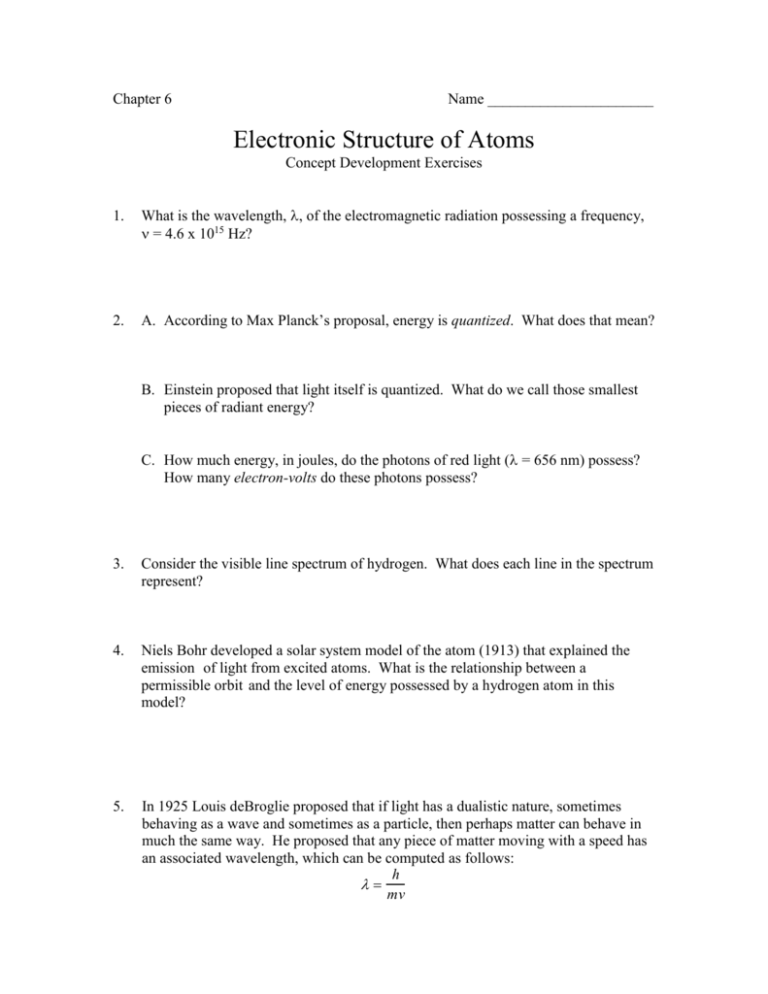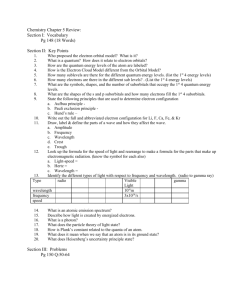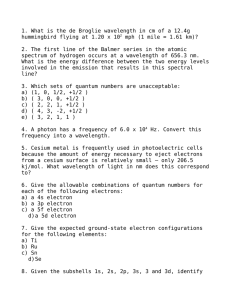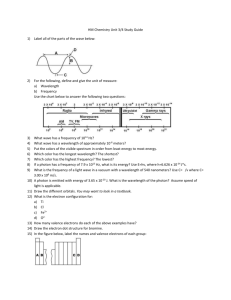Chapter 6 - Workforce3One
advertisement

Chapter 6 Name ______________________ Electronic Structure of Atoms Concept Development Exercises 1. What is the wavelength, , of the electromagnetic radiation possessing a frequency, = 4.6 x 1015 Hz? 2. A. According to Max Planck’s proposal, energy is quantized. What does that mean? B. Einstein proposed that light itself is quantized. What do we call those smallest pieces of radiant energy? C. How much energy, in joules, do the photons of red light ( = 656 nm) possess? How many electron-volts do these photons possess? 3. Consider the visible line spectrum of hydrogen. What does each line in the spectrum represent? 4. Niels Bohr developed a solar system model of the atom (1913) that explained the emission of light from excited atoms. What is the relationship between a permissible orbit and the level of energy possessed by a hydrogen atom in this model? 5. In 1925 Louis deBroglie proposed that if light has a dualistic nature, sometimes behaving as a wave and sometimes as a particle, then perhaps matter can behave in much the same way. He proposed that any piece of matter moving with a speed has an associated wavelength, which can be computed as follows: h mv A. Compute the wavelength of an electron moving with a speed of 5 x 106 m/s. B. What type of EM radiation would have the same wavelength? 6. The wave nature of electrons created the way for Heisenberg and Scrodinger to develop the science of quantum mechanics. The solution of Schrodinger’s wave equation led to establishment of quantum numbers that specify the energies and probable whereabouts of electrons in atoms. A. Define the four quantum numbers: n, l, ml, and ms. n: l: ml: ms: 7. How many electrons can occupy an s orbital? How about a set of p, d, or f orbitals? 8. What are the quantum numbers associated with each electron in a nitrogen atom? 9. State the aufbau principle: 10. Distinguish between an energy level and a sublevel. 11. Write the electron configuration for atoms of A. lithium, Li: B. sodium, Na: C. potassium, K: D. rubidium, Rb: E. cesium, Cs: 12. What do the electron configurations of the alkali metals have in common? 13. Why are the noble gases so noble? 14. Draw the shell diagrams for atoms of A. fluorine B. chlorine C. bromine 15. Identify the s-blocks, p-blocks, d-blocks, and f-blocks of the periodic table. This project is funded by a grant awarded under the President’s Community Based Job Training Grant as implemented by the U.S. Department of Labor’s Employment and Training Administration (CB-15-162-06-60). NCC is an equal opportunity employer and does not discriminate on the following basis: against any individual in the United States, on the basis of race, color, religion, sex, national origin, age disability, political affiliation or belief; and against any beneficiary of programs financially assisted under Title I of the Workforce Investment Act of 1998 (WIA), on the basis of the beneficiary’s citizenship/status as a lawfully admitted immigrant authorized to work in the United States, or his or her participation in any WIA Title I-financially assisted program or activity. This product was funded by a grant awarded under the President’s High Growth Job Training Initiative, as implemented by the U.S. Department of Labor’s Employment & Training Administration. The information contained in this product was created by a grantee organization and does not necessarily reflect the official position of the U.S. Department of Labor. All references to non-governmental companies or organizations, their services, products, or resources are offered for informational purposes and should not be construed as an endorsement by the Department of Labor. This product is copyrighted by the institution that created it and is intended for individual organizational, non-commercial use only.











